|
|
ARTHROPODS:
Insects»
Spiders»
Centipedes»
Millipedes»
Sowbugs»
Harvestmen»
Mites
& Ticks»
Scorpions»
Identification
Tips»
About
the Critter Files»
Links» |
|
|
|
| |
| TAXONOMY |
KINGDOM:
Animalia | PHYLUM: Arthropoda | CLASS: Insecta | ORDER :Diptera
| FAMILY: Tipulidae (crane flies) |
| |
| Other
Names: Tipulids, daddy-long-legs, leatherjackets (larvae),
skeeter eaters |
| |
WHAT
IS A CRANE FLY?
LIFE CYCLE
ECOLOGY
PEST STATUS
COMMON KENTUCKY CRANE FLIES
COLLECTING & PHOTOGRAPHY
CRANE FLY FACTS
MYTHS, LEGENDS, AND FOLKLORE |
| |
| WHAT
IS A CRANE FLY? |
|
| Crane Flies
belong to the family Tipulidae. Common crane flies are long
and thin with very long legs, and resemble giant mosquitoes. Unlike
mosquitoes, though, crane flies do not bite humans or animals. Crane
flies can be distinguished from other flies by the "V" shaped
suture on the thorax (shown below). Like all true flies (order
Diptera), crane flies have only 2 wings. |
| |
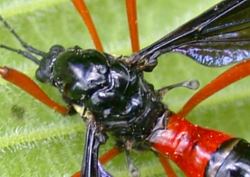 Crane fly: suture
(B. Newton, 2005)
Crane fly: suture
(B. Newton, 2005) |
|
| In many species,
male and female crane flies can be easily distinguished: females have
a pointy abdomen and males have a blunt abdomen. |
| |
 Female crane
fly, Ctenophora sp. (B. Newton, 2005)
Female crane
fly, Ctenophora sp. (B. Newton, 2005) |
| |
Immature
crane flies are legless and wormlike, and, like most fly larvae,
are very difficult to identify, even for experts. Some crane
fly larvae are very large, up to almost 2" long. Some
larvae develope a tough outer cuticle and are called "leatherjackets."
|
|
| SIZE:
Adult body length up to 1", larvae up to about 1 3/4 " |
| |
| LIFE
CYCLE |
|
Like all
flies, crane flies undergo complete metamorphosis with egg, larval,
pupal, and adult stages. The larvae are legless and wormlike,
and some are very large. Winged adults are active during warm
months, especially fall and spring, with different species of adults
active at different times during the year. Adults live only
for a few days; just long enough to mate and lay eggs. Most
species overwinter as larvae or pupae in moist soil, decaying vegetation,
or underwater. |
| |
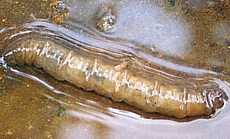 Crane Fly Larva
(B. Newton, 2004)
Crane Fly Larva
(B. Newton, 2004) |
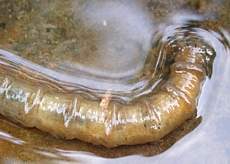 Crane Fly Larva,
detail (B. Newton, 2004)
Crane Fly Larva,
detail (B. Newton, 2004) |
| |
| ECOLOGY |
|
| Crane flies are associated
with moist habitats. The larvae of many crane fly species live
in moist soil where they feed on decaying vegetation or on plant roots.
Other species live in streams. Many stream-living crane
fly larvae feed on decaying vegetation, but some are predators of
aquatic insects and other invertebrates. Adult crane flies live
only a few days, and many species do not eat (some species are believed
to feed on nectar). Adults are usually active at night or in
shady areas during the day.
|
| |
| Soil-dwelling crane
fly larvae are fed upon by a variety of creatures, including spiders,
centipedes, and predatory beetles. Aquatic crane fly larvae
are fed upon by fish and aquatic insect predators, like dragonfly
naiads. Adult crane flies are a common food source for spiders,
praying mantids, and birds. |
| |
| PEST
STATUS |
|
Most crane
flies are beneficial decomposers. Rarely, large populations
of crane flies can cause damage to turf in poorly-drained soils.
Crane flies are sometimes a nuisance when large numbers of
adults swarm in urban lawns, but adults are harmless and do not
harm humans, animals, plants, food, or homes.
|
| |
| COMMON
KENTUCKY CRANE FLIES |
|
|
| GENERA:
Tipula, Ctenophora, Nephrotoma, others
There are dozens of crane
fly species in Kentucky, and most are similar in appearance and
biology. The most commonly encountered species are in the
Tipula genus, and these are typically 3/4" - 1"
long and gray or brown in color. Crane flies in the Ctenophora
genus are usually large (about 1" long) and shiny black, some
with red or orange markings. Some of these resemble wasps.
Members of the Nephrotoma genus are sometimes called
"tiger crane flies", and these species often have banded
color patterns. |
| |
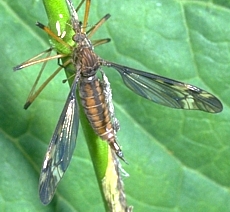 Tipula
sp., female (R. Bessin, 2000)
Tipula
sp., female (R. Bessin, 2000) |
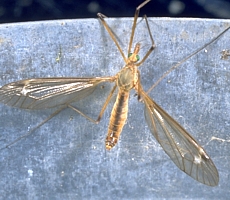 Tipula
sp., male (R. Bessin, 2000)
Tipula
sp., male (R. Bessin, 2000) |
| |
|
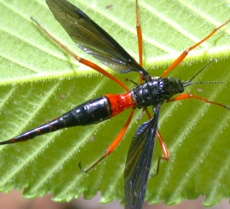 Ctenophora
sp., female (B. Newton, 2005)
Ctenophora
sp., female (B. Newton, 2005) |
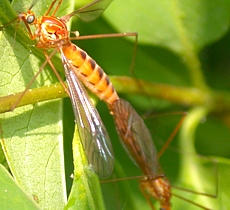 Nephrotoma
sp., mating (B. Newton, 2003)
Nephrotoma
sp., mating (B. Newton, 2003) |
|
| |
| COLLECTING
& PHOTOGRAPHY |
|
Crane
flies are common in Kentucky and can usually be found in cool, shady
places during the warm months in Kentucky. In the spring and
early fall they can be very common around homes. Crane flies
are poor fliers, so they are easy to capture with an insect net.
They will often remain still on a flower or leaf for a few
moments creating a good opportunity for a photograph.
Larval crane flies can
be more difficult to find. Some species are common in shallow,
fast-moving creeks and streams where they can be found under submerged
rocks and logs. Terrestrial larvae are harder to find, but
can sometimes be collected in rotten logs or moist soil. |
| |
| CRANE
FLY FACTS |
|
Crane flies are sometimes
called "daddy-long-legs," a name also used for certain
cellar spiders
and harvestmen.
None of these animals are closely related. This is an
example of why scientific names are important: often, several organisms
can share the same common name, or a single organism can have more
than one common name.
Chen Young maintains
the Crane Flies of Pennsylvania website which has
detailed info about many species of crane flies, most of which also
live in Kentucky:
http://iz.carnegiemnh.org/cranefly/index.htm
|
| |
| MYTHS
- LEGENDS - FOLKLORE |
|
Because they are sometimes
called "daddy-long-legs," crane flies are sometimes associated
with the mistaken belief that "daddy-long-legs are extremely
venomous, but cannot bite humans." Although it is true
that crane flies cannot bite humans, they are not venomous, and
neither are the other types of "daddy-long-legs." Read
more about this myth
at the University of Washington website.
Sometimes, crane flies
are referred to as "skeeter eaters." This is an
interesting name, but crane flies are not predators and do not eat
mosquitoes (not as adults, anyway: some larval crane flies are predatory,
and may occasionally eat mosquito larvae).
People sometimes refer
to crane flies as "male mosquitoes." This may have
come from the knowledge that male mosquitoes don't bite. Crane
flies are not male mosquitoes, although mosquitoes and crane flies
are fairly closely related.
|
Original document: 17 November 2005
Last updated: 14 October 2008
Photos courtesy R. Bessin and B. Newton, University of Kentucky
The Kentucky Critter
Files are maintained by Blake Newton, Department of Entomology, University
of Kentucky.
Contact: blaken@uky.edu
|
|

